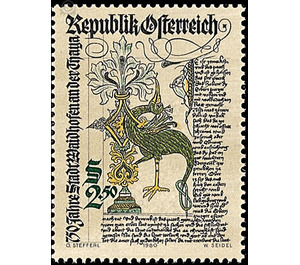750 years - Austria / II. Republic of Austria 1980 - 2.50 Shilling
Theme: Art & Culture
| Country | Austria / II. Republic of Austria |
| Issue Date | 1980 |
| Face Value | 2.50 |
| Color | multi-colored grey |
| Printing Type | combination printing |
| Stamp Type | Commemorative |
| Item Type | Stamp |
| Chronological Issue Number | 1001 |
| Chronological Chapter | OOS-OE2 |
| SID | 758799 |
| In 72 Wishlists | |
In the earliest times the Waldviertel was almost deserted and covered by jungle. Only along the river valleys there were settlements. This changed by the land acquisition of the mainly Bavarian settlers, who cleared the forest as planned from the 9th and 10th century. This created many new places. Above all, different noble families and monasteries played an essential role. The German settlement started from the Danube in a northerly direction. In the 11th and 12th centuries, the Thaya line was reached. The securing of the borderland to the north required the planned establishment of castle towns, in which task was combined with central economic function. In this way originated in the northern Waldviertel Weitra, Gmünd, Waidhofen on the Thaya, Drosendorf, each at strategically favorable places. The area of Waidhofen was populated by the ministerial family of Pernegger. On March 31, 1171 "Ortolfus de Waidehouen" is mentioned as Perneggerian Ministeriale in a document. It is the first written mention of Waidhofen dar. Waidhofen came in 1220 from the possession of the Counts of Pernegg to the Babenberger and around 1230 became a princely city. The brand image shows the title page of the "Waidhofner Stadtbuches" from the 14th century.


